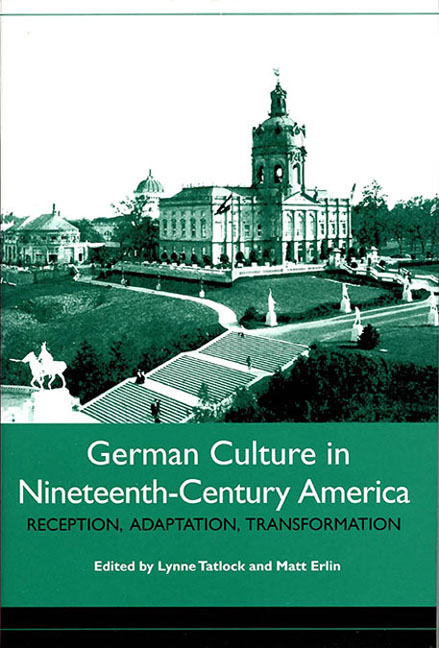Book contents
- Frontmatter
- Contents
- List of Illustrations
- Acknowledgments
- Introduction
- 1 Cultural Politics at the Turn of the Twentieth Century
- Cultural History: An American Refuge for a German Idea
- The Image of Culture — Or, What Münsterberg Saw in the Movies
- Tacitus Redivivus or Taking Stock: A. B. Faust's Assessment of the German Element in America
- The St. Louis World's Fair of 1904 as a Site of Cultural Transfer: German and German-American Participation
- 2 In Pursuit of Intellectual Culture
- 3 Translation American Style
- 4 Immigration and Naturalization Acts
- Contributors
- Index
The Image of Culture — Or, What Münsterberg Saw in the Movies
from 1 - Cultural Politics at the Turn of the Twentieth Century
Published online by Cambridge University Press: 13 April 2017
- Frontmatter
- Contents
- List of Illustrations
- Acknowledgments
- Introduction
- 1 Cultural Politics at the Turn of the Twentieth Century
- Cultural History: An American Refuge for a German Idea
- The Image of Culture — Or, What Münsterberg Saw in the Movies
- Tacitus Redivivus or Taking Stock: A. B. Faust's Assessment of the German Element in America
- The St. Louis World's Fair of 1904 as a Site of Cultural Transfer: German and German-American Participation
- 2 In Pursuit of Intellectual Culture
- 3 Translation American Style
- 4 Immigration and Naturalization Acts
- Contributors
- Index
Summary
In 1910 Hugo Münsterberg gave his inaugural address as the first Harvard exchange professor at the Berlin University. The lecture was titled “Die deutsche Kultur und das Ausland” (German Culture and Foreign Countries). In it he explains, “Der deutsch-amerikansiche Professorenaustausch war dem Wunsche entsprungen, mit dem Mitteln der höchsten Geisteskultur lebhaftere Fühlung zwischen den zwei voranstrebenden Völkern herzustellen” (1; the German-American professorial exchange emerged from the desire to foster mutual sympathy between the two leading nations by cultural means). Ironically, he noted, Germany had been slow to appreciate such means of asserting influence abroad. “Dunkel empfand man es, dass wenn politisch Deutschlands Zukunft auf dem Wasser liegt, geistig und kulturell ein gut Stück deutscher Zukunft jenseits des Wassers liegt” (3; Gradually it dawned on us that, if Germany's political future lies on the high seas, then much of its spiritual and cultural future lies on the other side of the water). German culture represented an untapped source of international power that would complement naval or military force. “Je mehr Deutschland von seiner Geistesarbeit ans Ausland abgibt, desto reicher wird sein Kultureinfluss in der Welt” (3; The more Germany transfers its cultural work to foreign countries, the richer will be its cultural influence in the world). To that end, Münsterberg announced, he would also direct the newly established Amerika-Institut in Berlin. Located in the new building of the Royal Library, it officially aimed to promote cultural relations between Germany and the United States by operating as what he termed (in English) an “intellectual clearing house.” Yet there was more at stake here than “mutual understanding” or academic exchange. Münsterberg envisioned the Amerika-Institut as a model for a much larger, future project, “ein sorgsam geknüpftes Netz internationaler Kulturpolitik [die] mit seinen Fäden den Erdkreis umspannt” (6; a carefully connected network of international cultural politics that would span the entire globe). In closing, the Harvard psychologist offered what he characterized as the most significant contribution to cultural exchange available to him: “Es ist die nachdrückliche Betonung, dass die mächtigste, nachhaltigste, tiefste deutsche Einwirkung in der weiten Welt stets von dem deutschen Idealismus ausging” (9–10; The emphatic assertion that the most powerful, lasting, and profound German influence in the entire world will always emanate from German idealism).
- Type
- Chapter
- Information
- German Culture in Nineteenth-Century AmericaReception, Adaptation, Transformation, pp. 21 - 42Publisher: Boydell & BrewerPrint publication year: 2005

